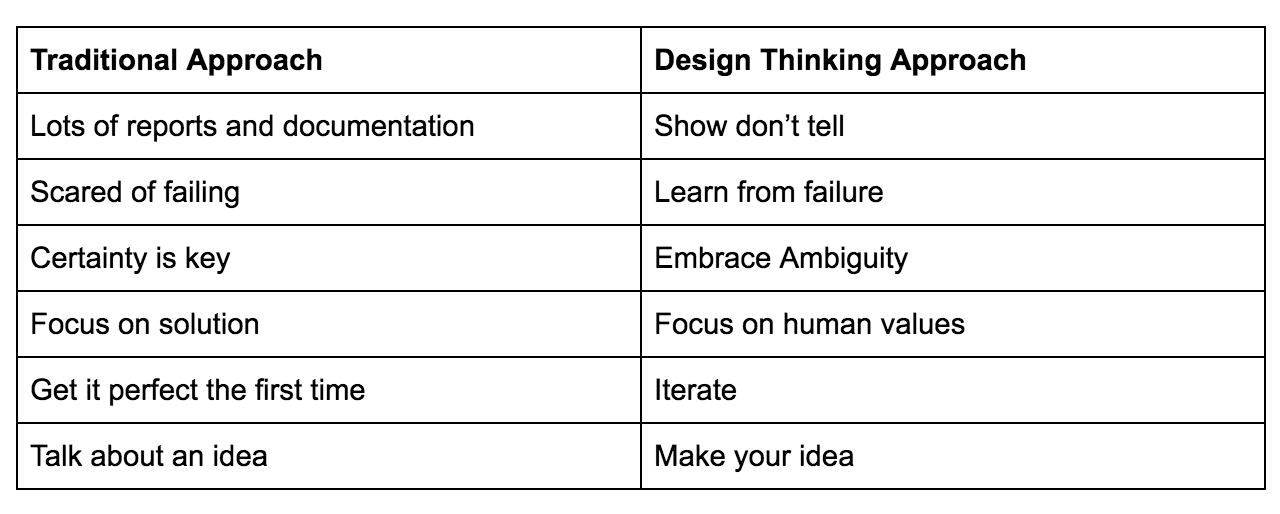8 Common Misconceptions About Design Thinking


Creating a culture of creativity is becoming a priority for organisations all across the globe, with 82% of companies believing that there is a strong connection between creativity and business results. Design Thinking is being used as a vehicle to foster this creativity and drive growth. However, many misconceptions still exist in the corporate world about design thinking.
Here are 8 common misconceptions about design thinking:

Peter Drucker famously said, “you can't manage what you can't measure”. Companies often fall into the trap of implementing a new methodology but failing to measure its success. Design thinking is often implemented within organisations but not measured, however there are several ways the success can actually be measured.
Here are a few ways to measure the ROI on design thinking:
Give it some time and use these measures to see if design thinking has ‘moved the needle’.

Design thinking isn’t just a gimmick, it is actually leading to some incredible outcomes. For example, Bank of America was able to gain 10 million new customers after applying design thinking.
Bank of America was looking for a way to increase the use of their savings accounts by customers. They applied the design thinking methodology and started engaging with customers to uncover insights. They found out that that people liked the act of saving more than the actual amount they save. For example, customers would get the same good feeling if they deposited $50 a month compared to $600 at the end of the year.
From this insight Bank of America developed the round-up concept, a product that allows customers to save with every transaction that they make. As a result, customers are able to get that same good feeling after every transaction. The outcome was staggering with Bank of America gaining over 10 million new customers and $1.8 billion in savings for them.
Here are five more success stories from companies like Nike, Starbucks and Nordstrom.

Even though the value of design thinking is clear, it is still hard to define as part of a business strategy. Good news - there are statistics out there that show the positive impact made by design thinking in business. In a study conducted by The Design Management Institute, design-led companies in the United States outperformed the S&P by over 200% (2015). The below chart outlines the success of design-centric companies such as Apple, Starbucks and Nike, compared to the S&P 500.
Applying design thinking principles has played a pivotal role in these companies staying ahead of their competition.
ADVERTISEMENT
ADVERTISEMENT

Much like when start-ups pitch to investors, employees need to approach management like they are pitching their own start-up.
“There’s no shortage of remarkable ideas, what’s missing is the will to execute them.” Seth Godin
Within the corporate world it isn’t just the execution that is missing, it is the ability to sell the idea before you get the opportunity to execute. Buy-in from management is crucial with any idea in the corporate environment.
The following is a structured approach that you can follow to put together a 5-minute pitch for management with your design thinking outcomes:

How is the design thinking process any different from the way companies have always approached problem-solving? The differences between the traditional approach and design thinking are highlighted in the table below.

The major difficulty people have when adopting design thinking is the drastic change required in mindset. Design thinking requires a certain mindset to ensure successful application. Some of the characteristics of the mindset include:

Would you be shocked if you were told that design thinking is also a form of risk mitigation?
Well, design thinking actually allows us to determine which ideas are worth taking to market and which ones we should pour cold water over. This could end up saving your organsiation thousands of dollars and hundreds of hours of employee time. The misconception is that design thinking is a risky process - it actually helps reduce risk and companies are usually just risk-averse to trying a new concept and challenging the status quo.

The five stages of Design a Thinking have been outlined in a linear order for ease of explanation but don’t view it as a linear methodology. Design Thinking is a method to help accelerate innovation but it is also important to note that Design Thinking is a non-linear process. For instance:

Those without an understanding of the design thinking methodology see it as the solution to every problem in the organisation. Bringing design thinking into a project that is already on the path to failure will not demonstrate the power of design thinking. Design thinking takes a human-centred approach and its impact will be diminished on a project that is already implementing a solution that your customer does not want. Apply it where it makes sense to do so!
It is imperative that every leader looking to implement design thinking in their organisation is aware of these misconceptions and ensures their teams are too.
.png)
The WorkFlow podcast is hosted by Steve Glaveski with a mission to help you unlock your potential to do more great work in far less time, whether you're working as part of a team or flying solo, and to set you up for a richer life.
To help you avoid stepping into these all too common pitfalls, we’ve reflected on our five years as an organization working on corporate innovation programs across the globe, and have prepared 100 DOs and DON’Ts.
ADVERTISEMENT
ADVERTISEMENT